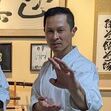Colin Wee's Blog
September 19, 2025
A Conversation on The Lost Scrolls of Ryukyu
Back in May 2025, I sat down with my editor David Moore here in Perth to talk through a new project we’ve been working on. It’s called The Lost Scrolls of Ryukyu, and while the title hints at something ancient and mysterious, the real story is about Karate—how it evolved, how it was shaped in resistance to the Japanese Empire, and how we might retell that journey through historical fiction.
The snippet we filmed is twelve minutes long, but it captures both of us bouncing ideas, challenging each other, and trying to talk about a narrative that respects martial tradition while exploring new creative ground.
That week, apart from other things, we talked about:
What Breaking Through revealed about Bassai Dai kata and practical bunkaiThe strengths and contrasts between hard style and soft style martial artsHow concepts like chi energy, structure, and manipulation play into trainingWhy historical fiction might be the right vehicle to explore Karate’s origins in RyukyuThe challenge of building character arcs from real martial arts personalitiesAnd how tactical decisions—like stripping soft-style elements from a new hard style methodology—affects both story and philosophyThere’s also a bit of behind-the-scenes talk: photography, editing, manuscript prep. Just two people trying to make something meaningful.
If you’ve read Breaking Through, you’ll probably see the through-line. This new project builds on the same foundation—kata as a living document, tradition as a conversation, and martial arts as a lens for understanding human conflict and growth.
I’d love to hear what you think. Better yet, if you’re on Goodreads, drop a question there. What would you want to see in a historical fiction story about martial arts? What kind of character would speak to you?
—Colin Wee
March 23, 2025
The Last Samurai
The Satsuma Rebellion of 1877 was a final stand by the samurai class against the sweeping reforms of the Meiji government. The Meiji Restoration had ushered in modernization, military conscription, and the abolition of the samurai, dismantling the very social order that had defined Japan for centuries. Many samurai saw these reforms as a betrayal—of their status, their traditions, and their very way of life.
Yet, despite their resistance, Japan as a whole was focused on a singular goal: preventing colonization by foreign powers. The country’s rapid modernization was not just about progress—it was about survival.
The film The Last Samurai captures this tension through the fictional Nathan Algren (Tom Cruise), a tortured military officer drawn into Japan’s internal struggle. In one pivotal scene, he clashes with Omura, a self-serving official whose commercial interests were tied to Japan’s new capitalist economy. Omura sought to marginalize the samurai, ensuring they had no place in this modernizing world. Algren, repulsed by Omura’s disregard for the human cost of progress, would later find himself identifying with the samurai.
The historical reality was even more brutal. The samurai’s final stand culminated in The Battle of Shiroyama, where Saigō Takamori, once a leader of the Meiji Restoration himself, chose to die for principle rather than accept the new order. Outgunned and vastly outnumbered, his forces fought until their last breath. Saigō, wounded, committed seppuku on the battlefield, his death marking the end of an era.
“Yet, the Samurai had been swept aside by the very nation they wished to protect.”
—Colin Wee, Excerpt from “The Lost Scrolls of Ryūkyū” (Unpublished Manuscript, 2025)
Many misinterpret The Last Samurai—it was not about a foreigner becoming Japan’s last warrior but about a man who chose to stand alongside the last of the samurai, honoring their code, their discipline, and their sacrifice.
By the time the Meiji era ended in 1912, Japan had fully transitioned into a modern imperial power. The samurai were gone. The country was now a rising force in the global arena. But for its annexed territories, such as Okinawa, modernization brought no relief. Okinawans remained dispossessed, their hopes for autonomy growing ever dimmer.
Historical fiction novel The Lost Scrolls of Ryūkyū follows a small group of Okinawans in this era, advocating for the establishment of a new system of Karate—one that could survive the political upheaval around them and improve their cultural security. As Japan entered the Great War, and as militarism took hold of the nation, these men were forced to ask themselves:
Were they building a legacy that would protect people—or a tool that would serve the empire?
Ankō Itosu’s proposal to the Ministry of War included the following in his second precept:
“If children were to begin training naturally in military prowess while in elementary school, then they would be well suited for military service.”
While the visuals of Itosu’s proposal didn’t look all that great in regards to the training of Japanese soldiers, the question was about who it would eventually serve and what it would become.
The Japanese people, too, were being swept into an era they were not fully prepared for. Modernization had cost them their samurai, their stability, and their traditions. And despite Okinawa’s own suffering, its masters saw that their knowledge could help anyone struggling to find their place in a changing world.
The above is a behind-the-scenes look at Colin’s latest historical fiction novel titled “The Lost Scrolls of Ryūkyū.” While you stay tuned for further updates, perhaps you’d care to explore the Occupied Okinawa: A Documentary Film by Robert Kajiwara from Peace for Okinawa Coalition.
March 20, 2025
Bushi Matsumura and the Boxer Rebellion
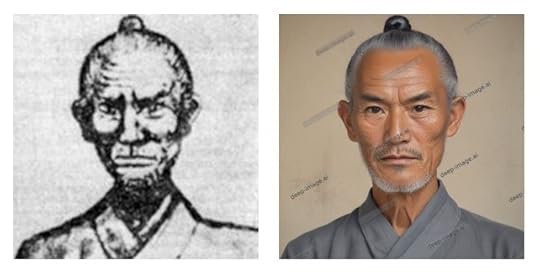 Bushi Matsumura Portrait Drawing on Left, and AI rendition from https://deep-image.ai/ on Right
Bushi Matsumura Portrait Drawing on Left, and AI rendition from https://deep-image.ai/ on Right“Recently, Ankō briefed us on the Boxer Rebellion in China, an uprising instigated by the Society of Righteous and Harmonious Fists … [who] were anti-foreign, anti-imperialist, anti-Christian, and ultra-violent. … the boxers believed an Eight Trigrams Society ritual … endowed them with spiritual protection, making them invulnerable to modern weapons. Hearing this, Sensei coughed out one of his rare laughs, startling the hell out of the two of us. Even Ankō, who had faced off samurai, pirates, a battalion of U.S. soldiers, local gangs, and his fair share of annoying bureaucrats was unnerved.”
– Colin Wee, Excerpt from “The Lost Scrolls of Ryūkyū” (Unpublished Manuscript 2025)
Historical fiction allows an author great liberty when working interpersonal relationships and exploring internal struggles which are both key in bringing a person to life. In saying this, a certain amount of effort has gone into “The Lost Scrolls of Ryūkyū” to present the history and people with care and fidelity.
There are two instances the book departs from this, and I’d like to talk about the one shared in the above excerpt. While I won’t give away too much, this is a scene between the legendary Matusumura Sōkon, Itosu Ankō, and Asato Ankō.
My eventual hope, of course, is a reader would pick up this book, get invested in the characters and their arcs, attempt independent research on the subject, and then discover the events and situations I have portrayed are indeed factual. Or, some would say, “real.”
When you drill into Matsumura’s backstory, however, you find his birth and death are wildly different dependent on the source you use. For instance, Wikipedia states Matsumura passes in 1899, which is the same year the Boxer Rebellion starts. Other sources list his passing in 1896 or 1901.
The Boxer Rebellion https://en.wikipedia.org/wiki/Boxer_Rebellion as explained in the excerpt was a violent uprising against what they saw was an increase in foreign invaders and collonialists in China. While the situation was explosive and complex, these sentiments mirrored sentiments of pre-Meiji era Japan. Elements of the Boxer Rebellion and the “mystical power” the boxers believed to have been granted by the Eight Trigrams Society ritual are featured in Jet Li’s Once Upon a Time in China movies (watch the first clip to the end, then see how their mudras fail them after getting a kick from Wong Fei Hong in the second clip 0:37).
Matsumura may have had an inkling of the foment happening in China leading up to the Boxer Rebellion. Up to his death, Ryūkyū Shimpo, the island’s newspaper, would have been in operation for 6+ years. The newspaper would have had experience by then covering the First Sino-Japanese war, the anti-Japanese sentiment, and the complex fractionated politics of Ryūkyū’s bid for independance.
Why I couldn’t resist bringing Matsumura and the Boxer Rebellion together was the huge contrast between the legendary Bushi Matsumura, his predilection for risk analysis, pragmatic combat, stategic preparation, and obsession with martial effectiveness, and the “Boxer fighters, [who were] convinced they were invulnerable to foreign weapons.”
In modern parlance, Bushi Matsumura would better be labelled as a RBSD or Reality Based Self Defense practitioner rather than a “Traditional Karate Master.” The face presented in the portrait above and the AI rendition on its right shows it all: a person who has spent a lifetime being the security advisor to the Ryūkyū Kingdom would be laser-focused on what works, avoiding any fantasy of being invulnerable to the weapons of the day.
We know this because Matsumura travelled extensively to acquire the skills and to refine knowledge that would make him a more formidable adversary. This is irrespective of Ryūkyū having been disarmed by their Satsuma overlords. Side note: for history buffs, Matsumura travelled to Foochow in 1860, and would have been a stone’s throw from the real Wong Fei Hong, who was the medical officer for the Black Flag Army in Guangzhou at the time.
So while facts may have been stretched, I felt the need to unfold the story this way to focus on the truths important to these masters. Readers may be interested to look into Matsumura’s makimono to understand the “true martial way” he described and the pitfalls he wanted all practitioners to avoid. These are relevant now as a warning against wishful thinking in martial arts as they were when they were written in 1882.
The above is a behind-the-scenes look at Colin’s latest historical fiction novel titled “The Lost Scrolls of Ryūkyū.” Stay tuned for further updates.
March 19, 2025
慈恩 Jion Temple Sound Kata
There’s something satisfying about peeling back the layers of a kata—tracing its roots, understanding why it evolved the way it did, and ultimately, figuring out what it’s trying to teach us. But it’s even better when you see how it all fits into the bigger picture.
Jion is one such kata. It’s a name that immediately conjures a certain kind of reverence—a sense of dignity, calmness, and restraint. But why? Where does it fit into our history?
If we go back to the years following the Ryūkyū Disposition, we find ourselves in a period of transformation. The old ways weren’t just under scrutiny—they were at risk of being lost altogether. The martial arts we had once trained in secret were now stepping into the public eye, and Itosu was the one leading the charge.
By the time Karate entered the Okinawan school system in 1901, Ankō had already been working on something new. Something scalable. Something that could be taught en masse without losing the essence of our training. It was during this time that the Pinan series was born, a structured set of forms designed to introduce students to the fundamentals in a way that could be replicated and standardized.
Jion was developed around this same time. Not a battlefield kata like some of the older ones, but one that embodied a shift in thinking—a kata designed not just for combat but for teaching control, poise, and an understanding of when not to fight.
Ankō himself had once explained it best:
“Jion doesn’t feel like a battlefield kata because it’s not meant to be. Not every fight starts with fists swinging. Some of the more dangerous conflicts I’ve been in were fought with words and gestures. Jion wasn’t about going for the win at all costs. It was about positioning, and choosing when—not if—you need to fight.”
This kata wasn’t simply a holdover from a bygone era—it was a message in a bottle, sealed with every lesson Ankō had fought to preserve.
The Shift from Tōde to KarateThis change didn’t sit well with everyone. Those who had trained in the old way, the way of Tōde, saw the modifications and scoffed. They thought the new curriculum was a dilution, a softening of what had once been fierce and raw.
This wasn’t about changing for the sake of change. It was about survival—not just of techniques, but of the culture itself. Karate couldn’t remain locked behind closed doors, taught in secret to a select few. It had to adapt, to become something that could outlast us.
Ankō understood this. When he asked Asato to document the names, addresses, and abilities of Okinawa’s martial artists, it wasn’t just about preserving the past—it was about securing the future. A future where the martial arts weren’t just practiced, but passed on.
That’s why Jion matters. Not just as a kata, but as a philosophy.
Jion, the Spirit of Karate, and JDK USA in Schenectady NYJDK’s Schenectady seminar 2024 was nothing short of electric—a fusion of sweat, skill, and strategy that brought the JDK Method to life. To everyone who participated, thank you. Your commitment, curiosity, and intensity turned this event into something truly special.
This seminar highlight both Bassai Dai and Jion, but wasn’t just about techniques—it was about training for the inevitable. It was about refining not just how we move, but why we move the way we do. For more information see joongdokwan.com.
Here are some key takeaways from the weekend:
 Beyond Technique: Anticipating the Opposition
Beyond Technique: Anticipating the Opposition
JDK isn’t about collecting fancy techniques—it’s about preparing for the fight that’s coming. We train for opposition, contingencies, and workarounds. A technique is only useful if it accounts for resistance.
 Unveiling the Hidden Layers of Tradition
Unveiling the Hidden Layers of Tradition
Kata isn’t just choreography—it’s a tactical playbook. We dissected, tested, and pressure-checked movements to ensure they hold up under realistic conditions. This isn’t about abandoning tradition; it’s about making it functionally relevant in the modern world.
 Shield or Springboard? Using the Enemy as a Tool
Shield or Springboard? Using the Enemy as a Tool
Sometimes, the attacker hands you an advantage—you just have to know how to take it. We explored how to redirect momentum, using an opponent’s own force as either a shield or a springboard to control the fight, create space, or set up a decisive counter.
 Ground Force: Kinetic Chaining for Devastating Power
Ground Force: Kinetic Chaining for Devastating Power
Striking isn’t about isolated limbs—it’s about harnessing the whole body. We trained to generate force from the ground up, connecting movements efficiently to maximize power. Imagine striking not just with your hand, but with the weight of the entire planet behind you.
This seminar wasn’t just about refining skills—it was about rethinking the way we approach martial arts. To everyone who attended, you now carry these lessons forward. Train hard, stay sharp, and keep pushing the boundaries of what you know.
See you at the next one!
The above is a behind-the-scenes look at Colin’s latest historical fiction novel titled “The Lost Scrolls of Ryūkyū.” Stay tuned for further updates.
Ryūkyū Awamori
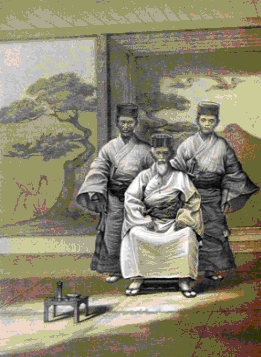 Lithograph of a photo taken by Commodore Matthew Perry of Ryukyuan Regent Sho Taimu, possibly flanked by Matsumura Sokon (left) and Itosu Ankō (right)
Lithograph of a photo taken by Commodore Matthew Perry of Ryukyuan Regent Sho Taimu, possibly flanked by Matsumura Sokon (left) and Itosu Ankō (right)Shinzato Shuzo, established in 1846, is the oldest existing awamori distillery in Okinawa, and it’s known for its traditional techniques and the quality of its products, which includes the Ryukyu Classic and Shinzato 7 awamori.
At the time of its inception, Matsumura Sōkon aka Bushi Matsumura would have served the Shō government for just over a decade, and a young Ankō Itosu would have only begun training under Matsumura. It would take another four year until he became Secretary of Ryūkyū Kingdom.
Shinzato Shuzo indicated that when Commodore Matthew Perry and his black ships stopped in Ryūkyū in 1853, there were only three distilleries on the island sanctioned by the government.
Perry “landed two cannons and two companies of U.S. Marines … Along with 50 naval officers and two brass bands” at Naha port before he literally invaded Shuri Castle (Clayton, Shotokan’s Secret p77).
This means the awamori Perry may have enjoyed could very well have been from their distillery. If so, the lithograph on the left, taken by the Commodore, may show some of their awamori being served in the drinking cup in the lower left hand corner of the frame. For more information see The story of Commodore Matthew C. Perry’s trip to Shuri Castle in 1853.
Shinzato Shuzo is characterized by a deep richness and smell of awamori on the nose. On the palate, it is fruity and has refreshing drinkability. With aging, sweetness and umami are enhanced, resulting in a smooth and profound flavor.
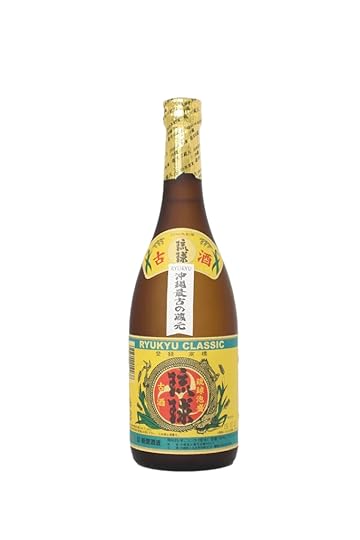 Ryūkyū Awamori Shinzato Classic
Ryūkyū Awamori Shinzato ClassicFor those interested in trying what Matsumura Sokon, Itosu Ankō and Asato Ankō were drinking at the time, click on the image to the right. For those of you who are interested to find out more of this culture see The essence of awamori.
Shinzato Shuzo reel on their Awamori, Commodore Matthew Perry, and their manufacturing process: https://www.instagram.com/reel/DGp3XmjzuQw/?utm_source=ig_web_copy_link&igsh=MzRlODBiNWFlZA==
View this post on InstagramA post shared by Letsgokinawa (@letsgokinawa)
The above is behind-the-scenes research used for Colin’s latest historical fiction novel titled “The Lost Scrolls of Ryūkyū.” Stay tuned for further updates.
Itosu deals with Drunk and Disorderly Patron
“Indeed, Itosu was so well trained that his entire body seemed to be invulnerable. Once, as he was about to enter a restaurant in Naha’s amusement center, a sturdy young man attacked him from the rear, aiming a hearty blow at his side. But the latter, without even turning, hardened the muscle of his stomach so that the blow glanced off his the right wrist of his assailant. Still without turning his head, he calmly dragged the man inside the restaurant.
Funakoshi Gichin
(Funakoshi, Karate-do: my way of life: Funakoshi Gichin, 1975, p15)
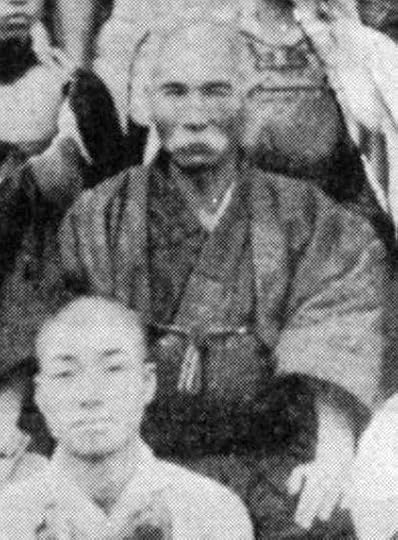 Az said he had heard of this incident but wasn’t there that evening.
Az said he had heard of this incident but wasn’t there that evening.
You’d be surprised how some strong, headstrong fellows behave. They feel the need to test themselves against someone well-known—sometimes as a drunken rite of passage, sometimes out of sheer arrogance. And let’s not forget the occasional grudge-holder who thought it was his duty to sneer at Shurite “parlor karate” or the new “empty hand shamisen” hacks.
Every time he heard that shamisen comparison he felt like hitting them with a real shamisen.
Anyway, this musclehead wasn’t looking for a fair fight, nor did he have the guts to come at Ankō from the front. He rushed in blindly, hoping to prove a point or end things quickly.
As for Ankō’s response? Exactly what we’d expect. We were always aware of our surroundings, even when relaxed. If the young man was making a scene, had poor footwork, or pulled back his arm before the strike, that would’ve been all the warning Ankō needed. He would brace his body, demonstrate the phenomenal conditioning he had acquired, and have the blow glance off without so much as a flinch.
Most men would have turned and retaliated. Ankō? He knew how to manage the optics. He calmly took control using soft power, dragged the attacker inside, and sat him down to sober him up. That’s the kind of man he was—no ego, and without the need for posturing. He knew he had nothing to prove. And by treating the fool with a little kindness, he landed the hardest hit of all.
The above is a behind-the-scenes look at Colin’s latest historical fiction novel titled “The Lost Scrolls of Ryūkyū.” Stay tuned for further updates. If however, you’re here for ideas on what to do if you’re faced with a drunk and disorderly person, please see WA Mental Health Commission: Managing an intoxicated person.
February 27, 2024
Exploring Past Your Comfort Zone: Colin’s Martial Arts Seminar in Schenectady, NY 2024
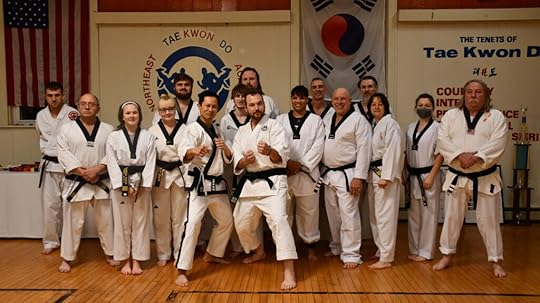 Participants at JDK;s Schenectady NY Seminar 2024
Participants at JDK;s Schenectady NY Seminar 2024Beyond the Comfort Zone
A trip to Schenectady, New York, for a martial arts seminar in January 2024 pushed me outside my comfort zone. It followed a successful seminar and book launch in Dallas the previous year and presented unique challenges, from planning a seminar without much of a lead time, to navigating unfamiliar territory, and reaching out to martial art schools.
Stepping Outside the Comfort Zone
While Dallas 2023 resonated deeply, the upcoming seminar in New York felt daunting. It was uncharted territory, a stark contrast to the familiar warmth of Dallas. Yet, it presented an excellent opportunity to strengthen my working relationship with the host Master Will Just, who had connected with me five years prior, and was my demonstration partner in Dallas. He was captivated by our training methodology, particularly its emphasis on extracting practical applications from traditional forms. He even harbored the ambitious dream of establishing a branch of Joong Do Kwan (JDK) in New York.
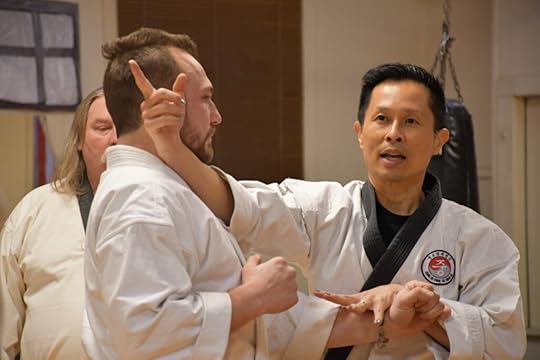 Colin demonstrates how a ‘receiving’ application can hit hard or soft on host Master Will Just
Colin demonstrates how a ‘receiving’ application can hit hard or soft on host Master Will JustFueling the Passion
Knowing his aspirations, I readily agreed to travel to New York when it coincided with my wife’s work trip. With her support, I encouraged Will to organize a seminar. However, the timing wasn’t ideal: the holidays and harsh winter weather presented significant hurdles. Undeterred by the challenges, Will, fueled by his positive experience in Dallas, mobilized his network, visited schools he wasn’t connected with, and promoted the event feverishly.
Commemorating and Moving Forward
As preparations progressed, a note of sadness shadowed our excitement. The trip reminded us all on the recent passing of my dear friend and book publisher, GM Mike Swope. His presence was deeply missed, and we spoke of him frequently throughout our time in New York, cherishing his friendship and guidance.
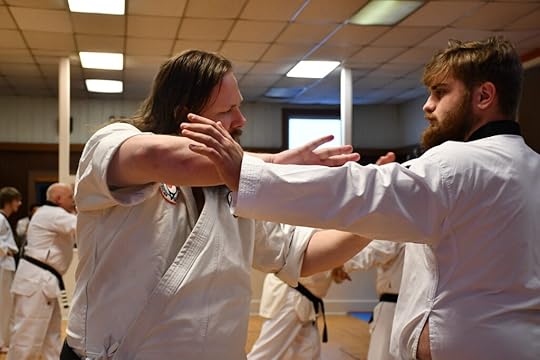 Jeff works a two-man application at Schenectady 2024
Jeff works a two-man application at Schenectady 2024A Leap of Faith
Another unexpected encounter happened just days before the event. Jack Berry, the new editor of Taekwondo Times, reached out through FaceBook messenger. He was intrigued by our approach and expressed interest in me contributing articles. Stepping outside his comfort zone, just like myself was doing, Jack saw the Schenectady seminar as an opportunity for growth and exploration.
Mental Readiness
The long flight to New York offered the opportunity to delve into the seminar material through mental visualization. Isolated from distractions, I envisioned myself presenting, engaging the audience, working with my demonstration partner, and tackling any potential challenges. Landing in New York, despite the fatigue from the journey, I felt confident and well-prepared.
Beyond Lost Luggage and the Tribulations of Travel
The warmth and hospitality of the local martial arts community offered a sense of belonging, and the focus shifted to the training itself.
The seminar delved beyond the realm of “fancy moves” and flashy techniques. Our focus was on unlocking the hidden potential of traditional forms and exploring their practical applications in dynamic real-world scenarios. We emphasized the importance of anticipation, sensitivity to the opponent, adapting to the opposition, and even turning their aggression against them, like a water droplet navigating a powerful torrent.
A highlight was witnessing a Grandmaster seamlessly blend her police experience with the seminar material, demonstrating the inter-relatedness of tactical skill. We are all branches of the same tree!
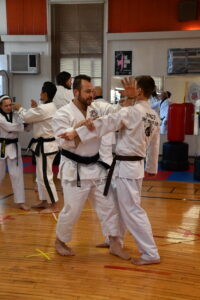 Master Will Just working a Knife Hand Strike on Taekwondo Times Editor Jack Berry at Schenectady 2024
Master Will Just working a Knife Hand Strike on Taekwondo Times Editor Jack Berry at Schenectady 2024Beyond Technique: Building Connections
Beyond the technical aspects, the trip fostered connections. Witnessing a passionate practitioner establish a new branch of my school in New York was incredibly rewarding. The genuine hospitality of the local martial arts community offered an unexpected sense of belonging.
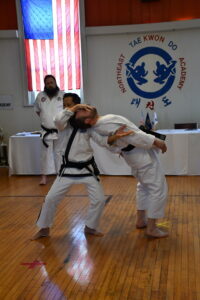 Colin Wee performs a number of unscripted skills, destabilizing Master Will Just off his base at Schenectady 2024
Colin Wee performs a number of unscripted skills, destabilizing Master Will Just off his base at Schenectady 2024Beyond Expectations
This journey to Schenectady, far from being just another martial arts seminar, became a transformative experience. It reaffirmed the value of venturing outside comfort zones, embracing the unexpected, and fostering meaningful connections. It served as a reminder that growth often lies beyond familiar territory, and that stepping outside our comfort zones can open doors to new possibilities and enrich our lives in profound ways. This odyssey, filled with challenges and unexpected encounters, solidified my commitment to sharing my knowledge, fostering connections within the martial arts community, and continuing to learn and grow both as an instructor and an individual.
Note: A short reel on this seminar can be viewed at https://youtu.be/A_OeUdtNtM8?si=eCdgQrmOrfM9NEE4
Bio: Colin Wee is the Principal of Joong Do Kwan Tae Kwon Do in Perth, Western Australia, Author of Breaking Through: The Secrets of Bassai Dai Kata, and winner of the Best Indie Book Award for Non-fiction Martial Arts.
November 28, 2023
In Loving Memory: Honoring Mike Swope, Our Publisher, and Friend
With heavy hearts, we bid farewell to a cherished member of our community, Mike Swope, who, at 55, left us on October 1, 2023, after a motorcycle accident. Beyond a publisher, Mike was a beacon of light, etching an indelible mark on our hearts and the martial arts world.
Mike joined The Study of Taekwondo Facebook group in 2009, becoming an integral part of our community. His passion for martial arts resonated in every post, forging connections that transcended the digital realm.
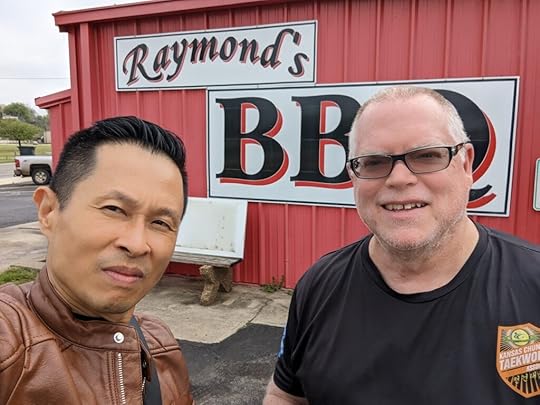 Colin Wee (left), and Mike Swope RIP (right) search out some amazing ribs during a lull in between launching the book and martial art seminars in March 2023.
Colin Wee (left), and Mike Swope RIP (right) search out some amazing ribs during a lull in between launching the book and martial art seminars in March 2023.In 2018, Mike’s talents as a writer and interviewer shone in Totally TaeKwonDo magazine. “An Interview with Sabumnim Colin Wee” showcased not just literary prowess but an understanding of camaraderie among high-level instructors. Little did we know, this marked the start of a beautiful collaboration.
In 2020, our paths crossed again with a manuscript. Entrusting Mike with “Breaking Through: The Secrets of Bassai Dai Kata” was an investment in a friendship that bloomed into something extraordinary.
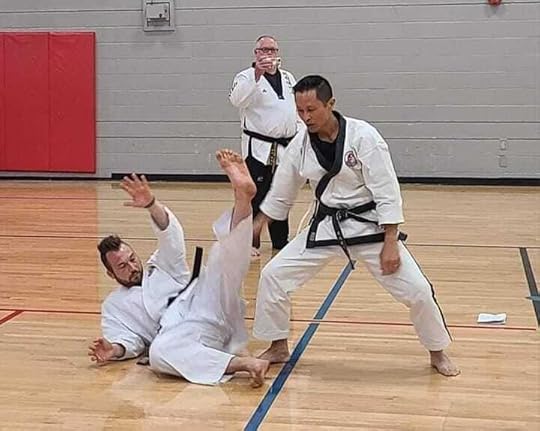 GM Mike Swope understood the power of the written word, but more importantly the visuals of a story.
GM Mike Swope understood the power of the written word, but more importantly the visuals of a story.Mike’s dedication was awe-inspiring. He saw beyond words, encouraging a rewrite to infuse more of “my voice.” A testament to his commitment, understanding of the interplay between words and illustration, and belief in authentic storytelling.
In March 2023, during a road trip around Dallas for the book launch, we met Mike in person. His warm smile mirrored the online friendship. Mike’s discreet contributions to our seminars showcased his humility and passion for martial arts.
Mike wasn’t just a publisher; he was a friend sharing our joys, challenges, and triumphs. His reviews reflected an authentic voice resonating with readers. His belief in our work fueled motivation during creative ups and downs.
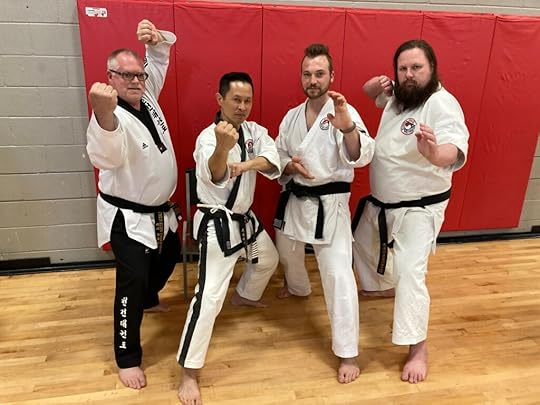 The Road Trippers 2023: GM Mike Swope, Colin Wee, Will Just, and Jeff Palm.
The Road Trippers 2023: GM Mike Swope, Colin Wee, Will Just, and Jeff Palm. Mike was a good friend, he will be missed.
As we grapple with Mike’s void, solace comes in tributes from the community. Phrases like “a stand-up guy” and “a great person who loved TKD” echo sentiments of many whose lives he touched.
Mike’s legacy transcends publishing. His passion for comic books, motorcycles, and sci-fi showcased the depth of his personality.
For condolences or Mike’s obituary, visit Mike Swope’s Obituary. As we navigate life without our friend and publisher, let’s cherish memories, shared wisdom, and the enduring impact of Mike Swope on our lives and the martial arts community.
November 12, 2023
Crossing Boundaries: A Taekwondo Instructor’s Journey into the Secrets of Karate’s Origins
Bassai Dai opens with a leap into a cross stance, backfist, and an open hand guarding block.
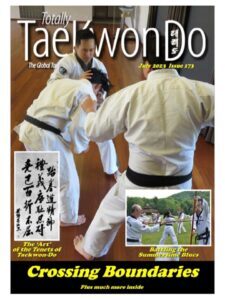
Bypassing an opponent’s lead guard, or oncoming strike, the immediate application we derive from this opening sequence has the technician take control of the opponent’s head and neck. What happens next rather depends on the situation. If absolutely necessary, we manipulate the opponent, crankshafting him around, and then propel his head like a basketball into the floor. Though it will not bounce. Much.
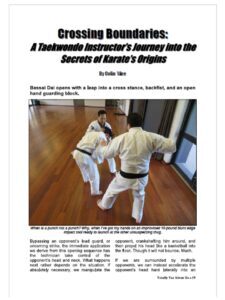
If we are surrounded by multiple opponents, we can instead accelerate the opponent’s head hard laterally into an object or structure, or catapult it straight into opponents who think they’re standing safely out of range.
Variations around the theme are equally brutal and unpleasant – for him.
If you’ve seen this application in my recent book, Breaking Through: The Secrets of Bassai Dai Kata, we have Hanshi Bruce Clayton to thank for all the fun.
No, this application is not stolen from Hanshi Clayton’s popular book, Shotokan’s Secret: The Hidden Truth Behind Karate’s Fighting Origins. But Dr. Clayton may still be held accountable. Shotokan’s Secret encouraged me to investigate the human condition of those early Karate pioneers, the combat scenarios they prepared for, the purpose of their various kata, and the absolute need for applications to be explosive.
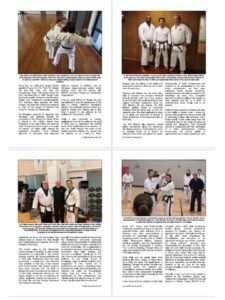 Pages from Totally Taekwondo show the people who matter to me
Pages from Totally Taekwondo show the people who matter to meBreaking Through, the title of my book, calls to the translation of Bassai as “breaking down the fortress” or “breaking out of the fortress.” As a spoiler, Shotokan’s Secret hypothesizes that Bassai was a team-based bodyguarding system, and along with several other kata, was central to the extraction of the royal family of Okinawa in times of threat.
Breaking Through is also thus titled because it required a huge shift in perspective on my part and no small effort to crack the secrets hidden in traditional source material.
I believe Breaking Through is the first book of its kind as it’s a book on kata application written by a Taekwondo teacher. Bassai Dai is, of course, a well-known Okinawan pattern, a precursor system to several modern hard-style fighting arts including Japanese Karate and traditional Taekwondo. So more than one lineage lays claim to it in their syllabus.
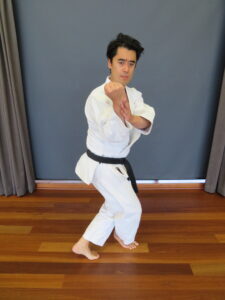 JDK’s Joshua Lay 3rd Dan runs through the kata
JDK’s Joshua Lay 3rd Dan runs through the kataWhile modern systems often emphasize the differences between styles, my ongoing research leads me to believe that practitioners prior to the 20th century frequently sought cross training opportunities from other systems. This meant that prior to the 1900s old school practitioners who braved the difficulties and dangers of travel could study a mix of Northern and Southern Shaolin arts, Okinawan Te, Japanese Koryu arts, and precursors of modern Muay Thai.
When South Korean Grandmaster Jhoon Rhee brought his system of training to the Southwest United States in the mid-1950s, what he taught wasn’t yet called Tae Kwon Do. It was Tang Soo Do, a literal translation of Karate as The Way of the China Hand, China Hand being a reference to the original name of Japanese Karate.
Tang Soo Do instructors taught Karate kata like Pyung Ahn 1-5, Tekki 1-3, Bassai Dai and Sho, Jitte, Jion, and Jiin. Grandmaster Rhee only started using the term Tae Kwon Do in 1962, though most Americans would continue to use the terms Karate and Taekwondo interchangeably. Our members then adopted the more modern Tae Kwon Do Chang Hon patterns in 1967 at the behest of General Choi Hong Hi, Founder of Taekwon-do.
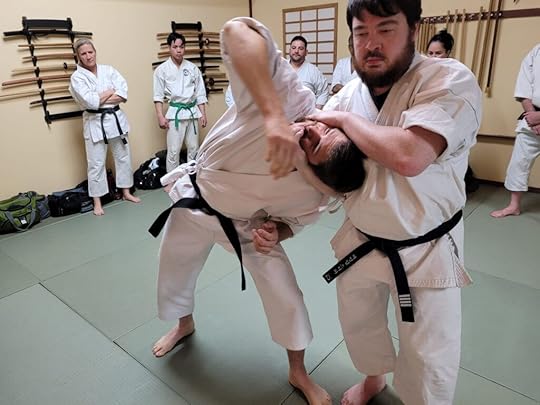 Members of Marudo Ryu Karate Do in Dallas play around with JDK concepts, March 2023
Members of Marudo Ryu Karate Do in Dallas play around with JDK concepts, March 2023Our lineage’s proximity to Japanese and Okinawan arts persisted beyond the conversion to the Chang Hon forms. When I arrived in the United States from Singapore in the early 1990s, my teachers used Chang Hon forms to put us through our paces, but black belts enjoyed an expanded curriculum, which included elements of Okinawan and Japanese patterns, aspects of Ju-Jutsu, and an Okinawan weapons-based system called Kobudo. Such was the training with AKATO, American Karate and Taekwondo Organization.
I had an early affinity for Bassai Dai and was pleased to see the appearance of the kata in Hanshi Clayton’s Shotokan’s Secret. The similarities various Chang Hon patterns shared with Bassai was a plus when I sought to use patterns as the syllabus for my training in 2005.
While I was interested to identify applications from all my patterns, the goal in 2005 was to understand the tactical worth of the traditional source material – to see the world through the eyes of the Karate pioneers. Bassai Dai, woven into the tapestry of our Chung Do Kwan lineage, was the oldest of the patterns I knew and it became a lens for me to peer back through time.
Working with Bassai Dai, we were often able to compare and contrast individual tactical phrases with the more modern forms we knew. We would deconstruct and explore technique sequences using the JDK Method. As one feature, the JDK Method applies tactics to oncoming initiatives from the same side, or from the opposite side. The best applications allow us to apply one technique to receive a strike irrespective of the opponent’s left or right side.
The JDK Method also assumes critical failure somewhere along the sequence. We always assume non-compliance. Such an obstacle forces us to search for solutions from within the pattern to create workarounds. If these workarounds are nowhere to be extrapolated in the form under consideration, we then seek inspiration further abroad, sometimes dredging through soft style concepts for the advantage we seek. This variegated approach to pattern analysis has reaped us huge rewards and led to a depth of understanding which simply had to be shared.
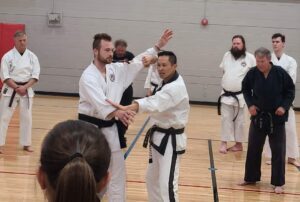 Colin in the midst of his March 2023 seminar at American Karate and Taekwondo Organization
Colin in the midst of his March 2023 seminar at American Karate and Taekwondo OrganizationWhile the book centers on Bassai Dai kata, it isn’t solely a how-to book. I share my journey and growth from being a white belt to becoming a black belt instructor, how I found myself 10,000 miles away from the mothership and on the verge of giving up martial arts altogether. That personal journey is juxtaposed with the challenges of a fixed pattern-based training environment, the various pitfalls or opportunities the modern practitioner may experience on his or her own journey, and various ways to extract the best results from traditional source material. This is the first part of the book.
The book’s value to the Taekwondo community lies in its ability to offer a fresh perspective on traditional, or old school, training material. My fundamental training in hard style Taekwondo does not need reinvention, I myself train new students very similarly to the way I was trained when I first started. The esoteric insight I have since acquired from the likes of Bassai Dai does not shake the foundations of hard style martial arts training nor the basics taught to me by my teachers. In reality, application training as I present in the book fills out that training framework and makes it come alive.
Any talk of a written martial art resource for the Taekwondo community eventually brings up the Encyclopedia of Taekwon-do written by the art’s Founder, General Choi Hong Hi. Undeniably, the Encyclopedia is an excellent resource. It provides amazing information that helps develop and structure a worldwide martial art. To this day, there is still nothing like it. But an over-reliance on any single source of knowledge might not always facilitate one’s progression in the martial art. If practitioners are open to assessing other perspectives while still understanding and enjoying the value the Encyclopedia brings, they are richer for it. The assessment of other perspectives may validate what they already know. Or might, in fact, identify areas they do not know.
Aside from theory and fundamentals, Taekwondo practitioners focus on fast and powerful strikes, often delivered from a distance, and often demonstrating a penchant for head-high techniques or techniques which require a lot of athletic ability. Close-range fighting, trapping, stand-up grappling, and joint manipulation are not equally emphasized in training. This is where Breaking Through offers an edge, as it presents skills that can enhance hard style training.
Such skills are not simply taken from systems like Judo, Jujitsu, or Wing Chun, as is often the case. The applications in Breaking Through are drawn directly from material within the pattern set. Extrapolated, pressure tested, and drilled, they point to the prerequisite knowledge the pioneers of the patterns developed and ensconced in their kata.
 Shout out to GM Mike Swope (RIP), Jeff Palm, and Will Just who supported me through the Dallas Road Trip.
Shout out to GM Mike Swope (RIP), Jeff Palm, and Will Just who supported me through the Dallas Road Trip.I didn’t stop at the boundaries of hard style concepts, either. Hard style techniques involve linear, forceful movements designed to displace and destroy an opponent’s structure. Soft style techniques, on the other hand, emphasize the immobilization and disruption of an opponent’s structure and center of gravity. By being platform agnostic and incorporating the discussion of both hard style and soft style tactical concepts, the analysis of forms comes alive! We then get to cherry pick tactics that work well at specific distances. This is the 21st century after all. If we want to learn certain tactical elements or develop defenses when faced with such opposition, we should have the freedom to do so. Just as the early pioneers traveled in order to broaden their knowledge.
Recently, it was my honor to be invited to present at the American Karate and Taekwondo Organization (AKATO) Annual Seminar in Dallas, Texas. AKATO is the organization with which I started my journey in Traditional Taekwondo. For my seminar, I chose to show skills drawn from those older forms that are part of our Karate and Chung Do Kwan legacy.
However, these aren’t sparring skills to be used in a sport-based martial arts setting. They are incredibly deceptive, subversive, and subtle. The applications include their own self-correcting mechanisms to match the dynamic situations you’d face with a live opponent. And like my first example where the opponent’s head becomes your basketball, all come with a level of shock and awe. Some have called it magic!
The smiles and nods of appreciation from the 130 or so participants became more enthusiastic as the level of discomfort inflicted on my demonstration partner increased. This is one of the reasons I wrote this book in the first place. Black Belts want this kind of information. It might have been informative talking about where the pattern originates, but when we see it for its tactical value, when we learn to shut down an opponent, when we feel the ease at which this happens, when we acquire the ability to account for multiple opponents — demonstration trumps everything!
As I reach the conclusion of the remarkable journey to write and present Breaking Through: The Secrets of Bassai Dai Kata, my heart swells with immense pride and fulfillment. This book has been a deeply personal endeavour, driven by my passion for martial arts and my need to express a gratitude to my teachers by showing what I have learned based on their teaching. It is a testament to my growth in their system and a testament to the continuing benefits of traditional training.
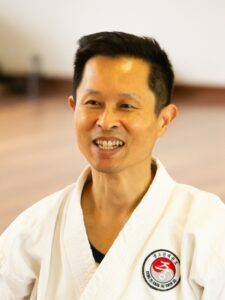 Author Colin Wee
Author Colin WeeI hope that Breaking Through serves as a guiding light for practitioners looking to explore the depths of their own training. It is my desire to empower martial artists with a fresh perspective, to bridge the gap between hard style and soft style techniques, to foster a deeper understanding of traditional martial arts training, and to encourage all to “break through” their own barriers in their lifelong quest for self-improvement. May this book be a source of inspiration, a catalyst for growth, and a taste of the exciting possibilities that await us on our martial arts journey.
About: Colin Wee has practiced three martial arts systems over three continents in the past 40 years. Colin was inducted into the Australasian Martial Arts Hall of Fame in 2020, and was formerly an Asst National Coach in Archery.
The original version of this article was submitted to and published in Totally Taekwondo Magazine July 2023 Issue 173.
August 10, 2023
What’s the Best Thing About Being a Writer?
The most rewarding aspect of being a writer in the martial arts niche is the opportunity to deeply connect with fellow practitioners who share my passion. This niche may not be a lucrative market, but the personal motivation behind my work stems from a genuine desire to contribute, inspire, leave a lasting impact, and to express my gratitude to those whom have contributed to my journey. The countless hours invested are fueled by the belief that sharing my insights and experiences can truly resonate with others on a profound level, fostering a sense of community and personal growth. It’s this shared journey and the potential to make a meaningful difference that makes the effort incredibly worthwhile.

